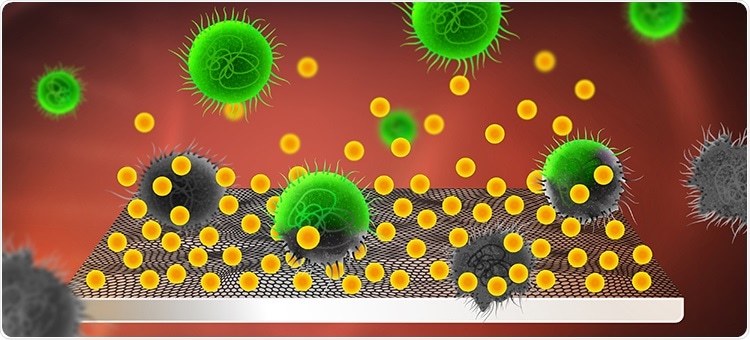Bacterial infections associated with medical implants place a major burden on healthcare and cause great suffering to patients across the world. Scientists from the Chalmers University of Technology have now devised a new technique to avoid such infections.

Usnic acid (yellow) is integrated in and released from the implant’s graphene coating. The usnic acid kills the bacteria (green) and thereby prevents them from forming infectious biofilms on the surface. Image Credit: Yen Strandqvist/Chalmers.
The technique involves using bactericidal molecules to cover a graphene-based material.
Through our research, we have succeeded in binding water-insoluble antibacterial molecules to the graphene, and having the molecules release in a controlled, continuous manner from the material. This is an essential requirement for the method to work. The way in which we bind the active molecules to the graphene is also very simple, and could be easily integrated into industrial processes.”
Santosh Pandit, Researcher, Department of Biology and Biological Engineering, Chalmers University of Technology
Pandit is the first author of the study that was published recently in Scientific Reports.
Some bacteria exhibit the ability to form impenetrable surface layers, or “biofilms,” on surgical implants, like dental and other orthopedic implants, posing a major threat for healthcare worldwide.
Biofilms are highly resistant compared to other bacteria, and thus the infections are usually difficult to treat, resulting in great suffering for patients. In the worst cases, it necessitates the replacement or removal of the implants. Apart from the effects on patients, this involves huge costs for healthcare providers.
Graphene is suitable as an attachment material
A wide range of water-insoluble or hydrophobic, molecules and drugs can be used for their antibacterial properties. However, to enable their use in the body, they must be bound to a material, and this can be challenging and labor-intensive to manufacture.
Graphene offers great potential here for interaction with hydrophobic molecules or drugs, and when we created our new material, we made use of these properties. The process of binding the antibacterial molecules takes place with the help of ultrasound.”
Santosh Pandit, Researcher, Department of Biology and Biological Engineering, Chalmers University of Technology
The researchers covered the graphene material with usnic acid extracted from lichens, for example, fruticose lichen. Earlier studies have shown that usnic acid exhibits optimal bactericidal properties.
It acts by inhibiting bacteria from synthesizing nucleic acids, specifically preventing RNA synthesis, thereby inhibiting protein synthesis in the cell. The researchers tested usnic acid for its resistance to the pathogenic bacteria Staphylococcus aureus and Staphylococcus epidermidis, two common perpetrators responsible for the formation of biofilm on medical implants.
Simple method paves way for future drugs
The new material developed by the researchers exhibited several potential properties. Besides achieving successful results for combining the usnic acid into the graphene material’s surface, they also noted that the usnic acid molecules were discharged in a controlled and continuous way, thereby inhibiting the formation of biofilms on the surface.
Even more importantly, our results show that the method for binding the hydrophobic molecules to graphene is simple. It paves the way for more effective antibacterial protection of biomedical products in the future. We are now planning trials where we will explore binding other hydrophobic molecules and drugs with even greater potential to treat or prevent various clinical infections.”
Santosh Pandit, Researcher, Department of Biology and Biological Engineering, Chalmers University of Technology
Source:
Journal reference:
Pandit, S., et al. (2021) Sustained release of usnic acid from graphene coatings ensures long term antibiofilm protection. Scientific Reports. doi.org/10.1038/s41598-021-89452-5.